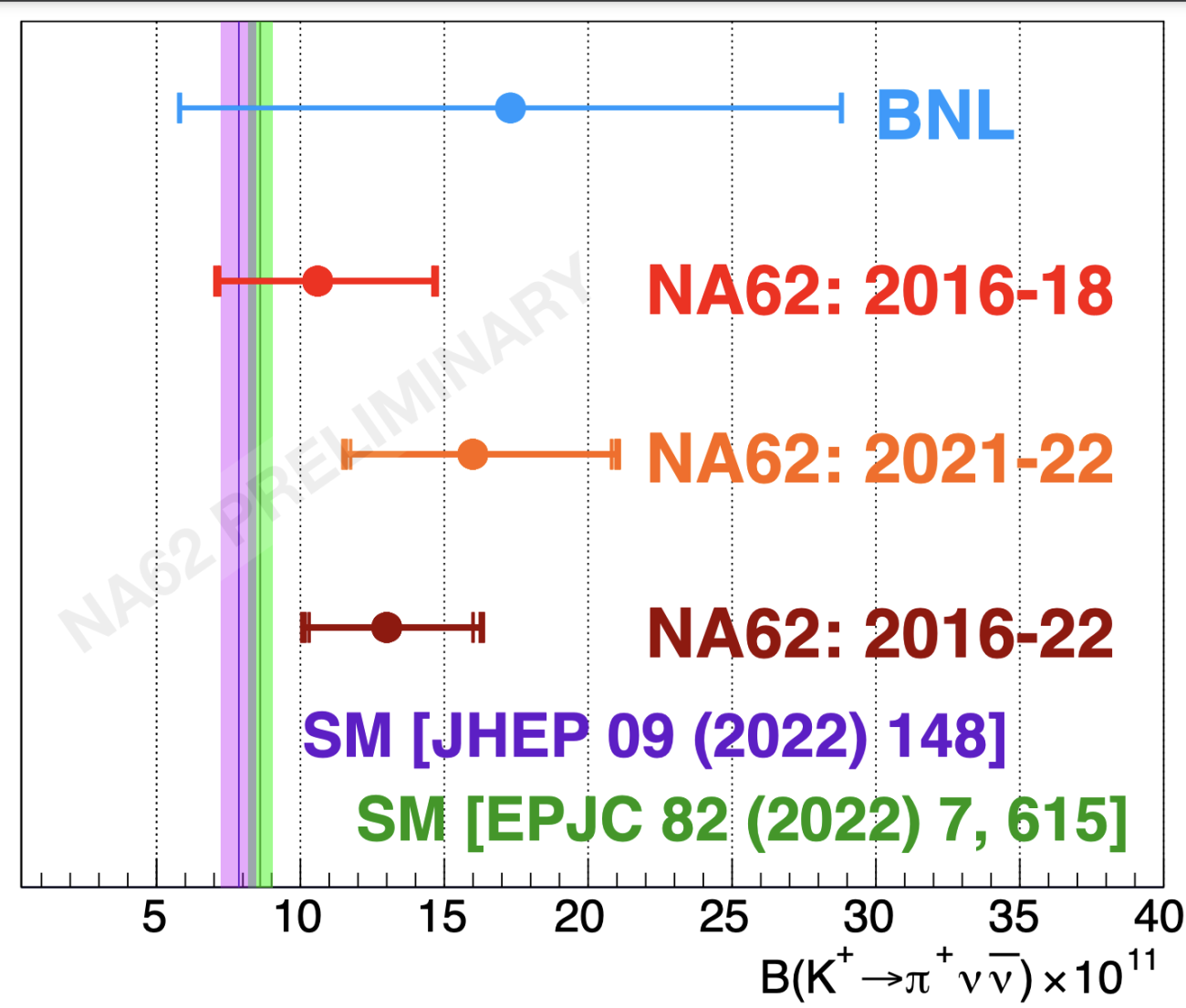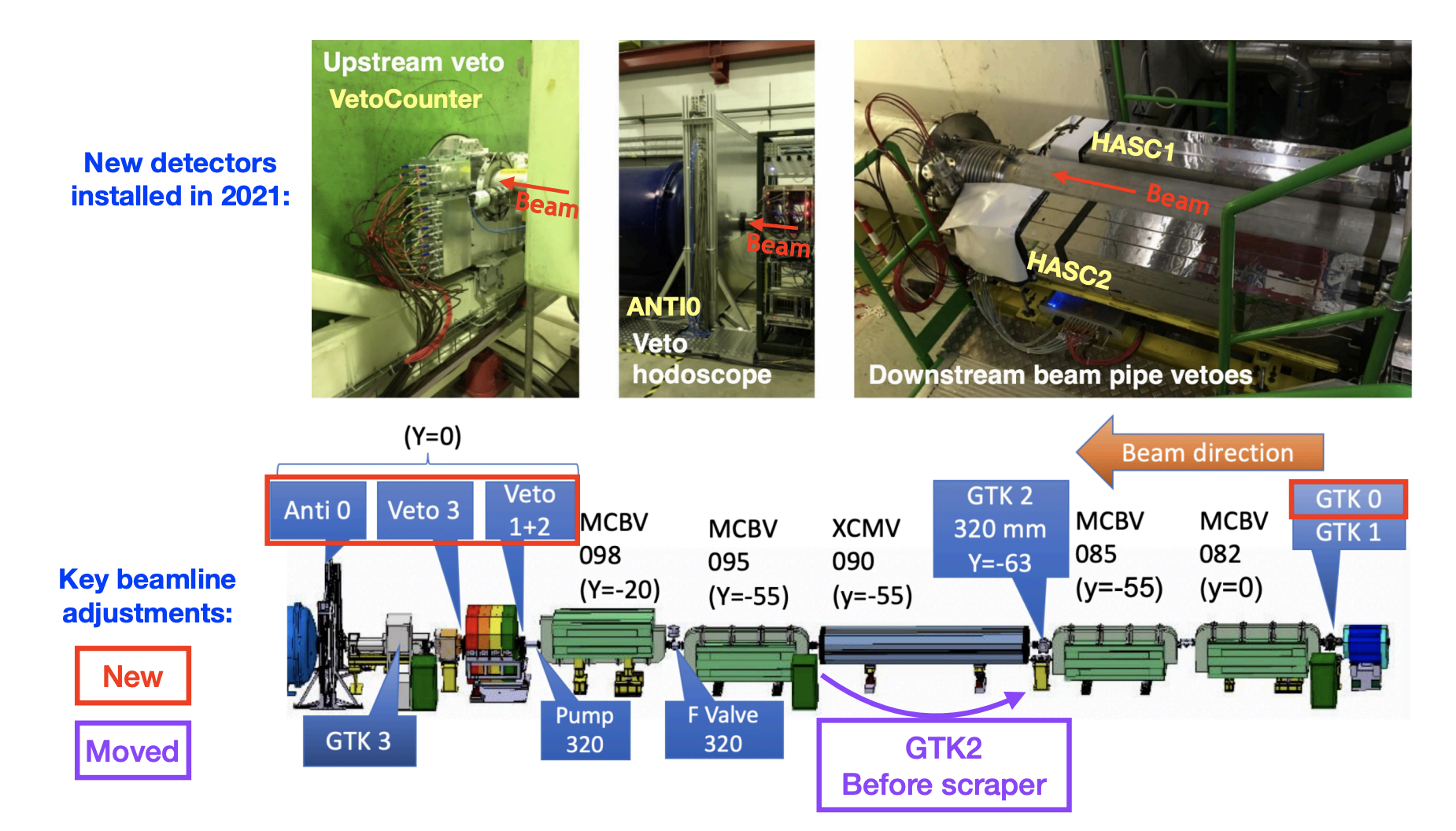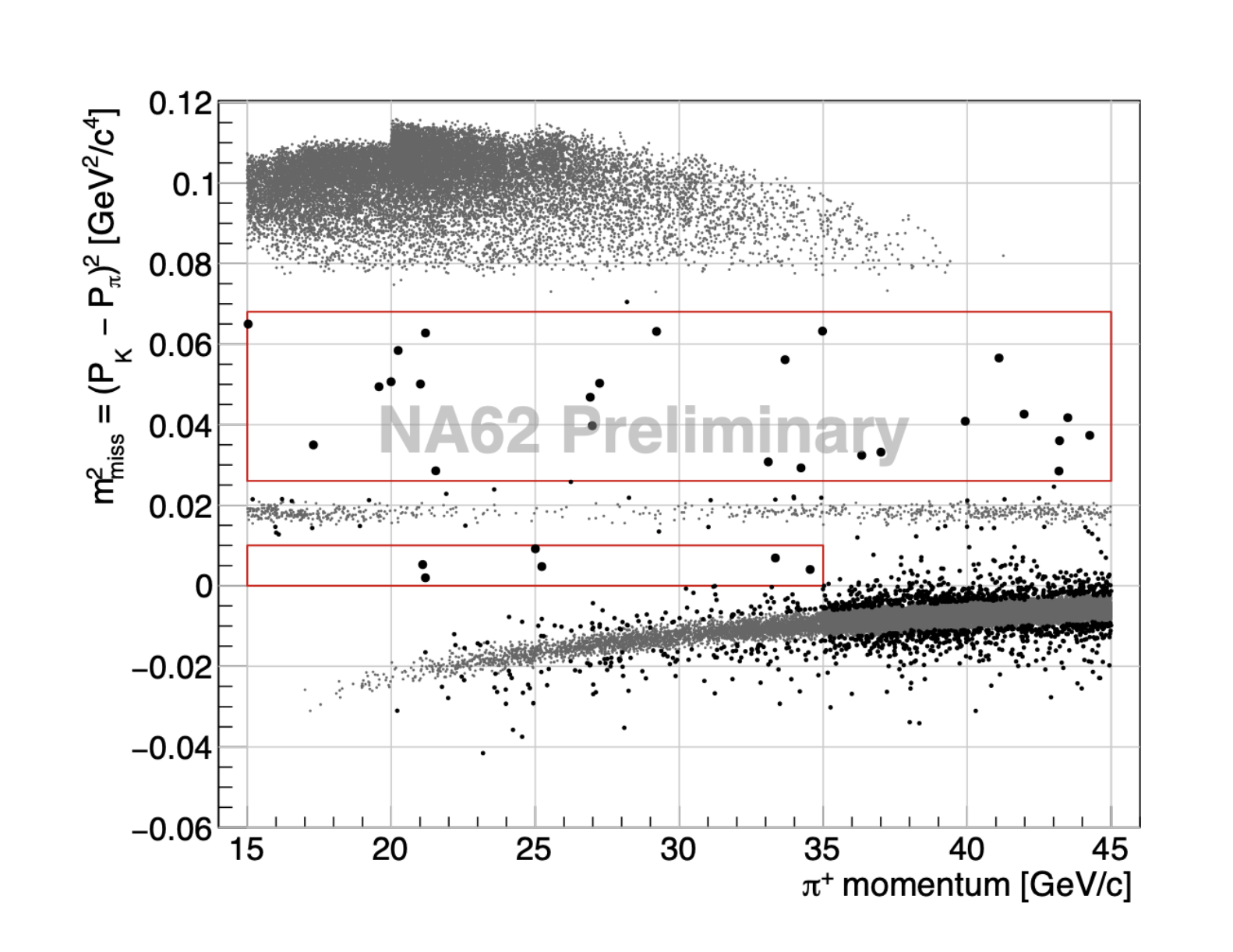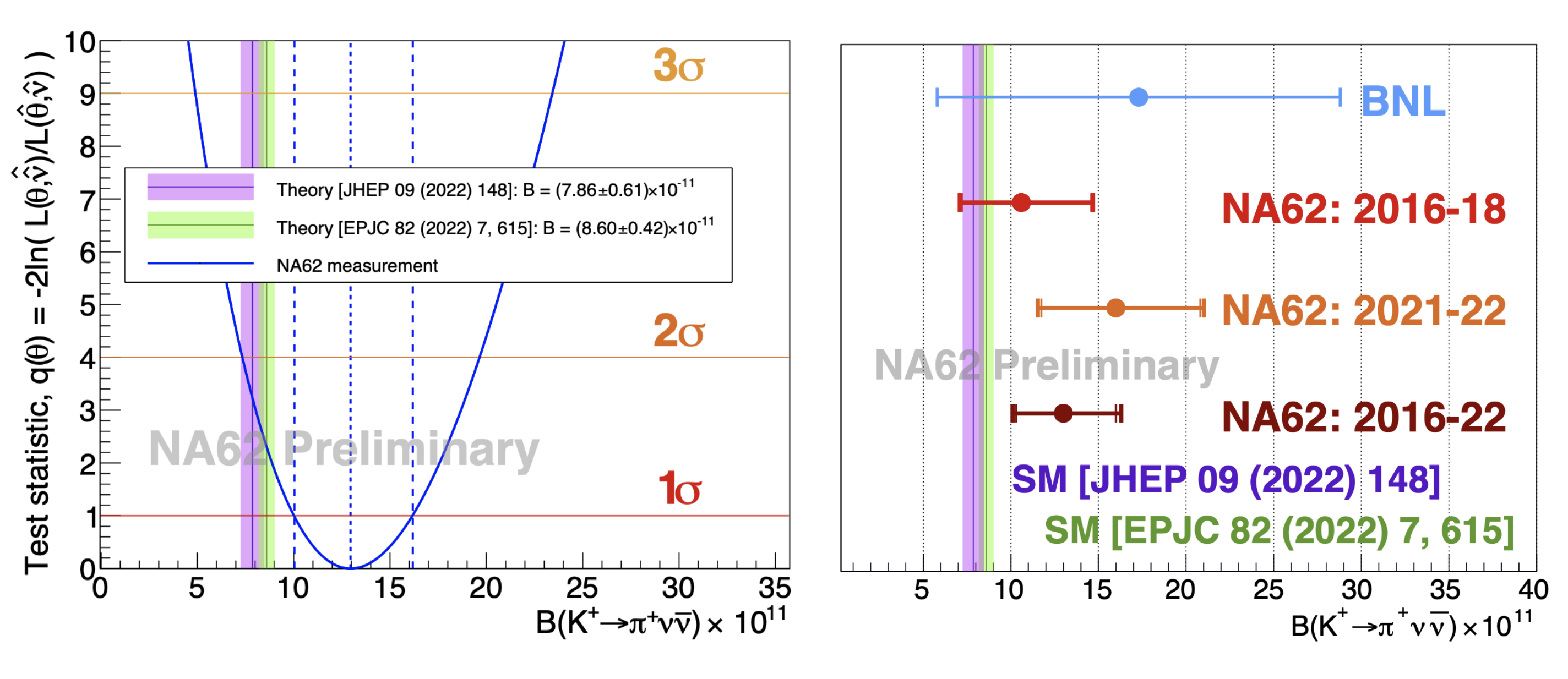NA62 Observes Ultra-Rare Kaon Decay to Pion and Neutrinos

The NA62 experiment at the CERN north area was built to investigate the ultra-rare K+ → π+νν̄ decay. Measurement of this decay, a golden mode for kaon physics, is considered a key flavour physics objective because it provides both a strong test of the Standard Model (SM) and a sensitive probe for new physics beyond the standard model (BSM). The K+ → π+νν̄ decay is both very rare and very precisely predicted in the SM, with a predicted branching ratio of approximately 8 × 10−11 (EPJC 82 (2022) 7, 615, JHEP 09 (2022) 148), with an intrinsic theoretical prediction below 5%. However, this decay is highly sensitive to new physics contributions, and in multiple BSM scenarios, significant changes to this branching ratio are predicted.
To study this decay experimentally is challenging, to say the least. The neutrinos in the final state are not observed, so the experimental signature is a K+ entering the experiment, a π+ to be detected downstream, and missing energy/momentum. The problem is that while less than 1-in-1010 K+ decay to our signal final state, the other 1010 decays may fake the same experimental signature. Nevertheless, analysis of data collected in 2016–2018 (JHEP 06 (2021) 093, see also EP newsletter of 18th September 2020) demonstrated the effectiveness of the NA62 experimental strategy, observing 20 events with approximately 7 ± 1 expected background and 10 SM signal events. This provided the first evidence for the K+ → π+νν̄ with 3σ significance and a branching ratio measurement of B(K+ → π+νν̄) = 10.6+4.1−3.5 × 10−11.
To achieve this result, maintaining a background comparable to the expected SM signal yield, aggressive selection cuts were necessary, compromising signal yield. To improve this, new tools were needed to control the background without reducing the signal yield. During Long Shutdown 2 (LS2), a raft of upgrades was performed, transforming NA62 and adding new detectors. These changes were discussed in detail in the EP newsletter of 31st December 2021, and are shown in Figure 1. One highlight is the addition of a new upstream veto detector (the VetoCounter), which reduces the upstream background due to decays before the final collimator by a factor of ~3, with negligible signal loss. Additionally, for the VetoCounter, a novel DAQ system was developed based on the Front-End LInk eXchange board (FELIX, developed for use in the ATLAS Run3 upgrade), which allows asynchronous continuous readout.
The beam-line was also modified, in particular adjusting the upstream achromat. This facilitated the addition of a fourth beam tracker (GTK) station, improving efficiency and strengthening resilience to pileup. The penultimate GTK station was moved upstream of the final scraper to further block beam-GTK interaction products. In addition, the intensity of the 400 GeV SPS beam delivered to NA62 was increased by around 40%. With feedback from the high-precision NA62 detector and the expertise of the BE-OP and SY-RF groups, an interesting feature of the beam delivery in the first second of the 4.8-second spill was identified. This resulted in ultra-high instantaneous spikes in intensity in 2021, and was solved for 2022 and onwards (see NA62 SPSC-SR-326).
New data quality monitoring systems were established, with a new data quality expert role, to rapidly check and validate all new data using both low- and high-level observables directly relevant to the study of the K+ → π+νν̄ decay. This task was possible from any location and allowed NA62 collaborators from around the world to continue performing essential roles throughout the period of travel restrictions during data-taking in 2021.
These changes, coupled with re-optimisation of the selection for high intensities and using the new detectors, allowed a significance increase of 50% in the expected SM signal yield per SPS spill in 2022 data with respect to 2018 data. The precision of the signal sensitivity expectation is improved by almost a factor of 2, primarily through the cancellation of systematics using a new trigger scheme and improved measurement strategies. Meanwhile, the background is maintained at a similar level to the expected signal, giving a similar, if slightly improved, sensitivity for the branching ratio measurement for the new data.

Figure 1: Additions and modifications to the NA62 experiment utilised from 2021 onwards.
In the new 2021–2022 dataset, approximately 11 ± 2 background events are expected alongside approximately 10 Standard Model (SM) signal events. In the signal regions, 31 events are observed (see figure 2). A measurement of the branching ratio is then performed using a profile likelihood ratio test statistic, with six analysis categories defined by the candidate π+ track momentum, resulting in a measurement of B2021-22(K+ → π+νν̄) = 16.0+5.0−4.5 × 10−11.

Figure 2: Distribution of observed events satisfying the final signal selection criteria in the (pπ+, m2miss) plane, where pπ+ is the momentum of the candidate π+ and the squared missing mass is defined as m2miss = (PK − Pπ)2, where PK and Pπ are the measured 4-momenta of the K+ and π+ candidates, respectively.
These results from the new 2021–2022 dataset are combined with those from the 2016–2018 data. In total, 51 events are observed, compared to a total background expectation of 18+3−2. For the first time, this constitutes an observation of the K+ → π+νν̄ decay, excluding the background-only hypothesis with a significance in excess of 5σ. Additionally, the branching ratio is measured, with a 25% relative precision, to be B2016-22(K+ → π+νν̄) = 13.0+3.3−2.9 × 10−11, see figure 3. Interestingly, while this result is compatible with the SM prediction within 2σ, the central value is approximately 50% larger than the SM prediction.

Figure 3: (Left) Results from the statistical analysis of 2016–2022 data. (Right) Summary of measurements of B(K+ → π+νν̄).
This milestone result was made possible through the persistent effort of the entire NA62 collaboration, from its conception around two decades ago, through construction, extensive data-taking campaigns, and painstaking analysis of the data. With data-taking continuing up to LS3, NA62 has a unique opportunity to further investigate this decay and clarify the level of agreement, or tension, with the SM. Analysis of the next dataset is already in progress, so stay tuned for more results from this research, as well as from the broader NA62 physics programme (see also CERN article on 9th August 2024 on searches for long-lived particles).
